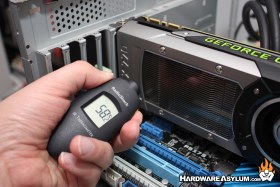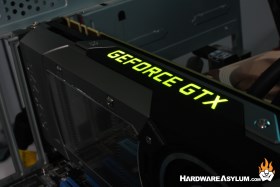NVidia GTX 770 Video Card Review
Author: Dennis Garcia
Published: Thursday, May 30, 2013
Conclusion
Some of you may be left wondering about the GTX 770, according to the specs the GPU is identical to the GTX 680 with the addition of a higher clock speed, different PCB and faster memory interface it is. The memory width is still 256-bit but the memory clock is considerably higher giving you a 7Ghz data rate for a total memory bandwidth of 225 GB/s. DirectX 11 technologies will take advantage of this especially considering that to get the most from our games we need to do a number of things including increasing detail settings and resolution. Both of these require a lightning fast memory interface and a GPU to get the data moving. GTX 770 gives you that, and then some.
During our testing the card ran extremely well and at about where you would expect over the GTX 670. The card was giving the MSI R7970 Lightning a run for its money and considering that Nvidia has targeted this GPU at a price point owned by the Radeon HD 7970 ($400 USD) we see this as a major win. Of course this card is no GTX 780 or even a GTX Titan but if you're still using a GTX 580 or, lower end 600 series card the GTX 770 might be a good upgrade opportunity.
Overclocking is a big part of the enthusiast community so we tend to look for special card designs that help us overclock without having to resort to extensive board modifications. The reference NVidia GTX 770 is not one of those cards however. The GPU does overclock quite well under GPU Boost 2.0 and with static clock increases. In our test we got an extra 300Mhz out of the core and were pushing 1900Mhz in memory before the card had trouble completing benchmarks. Considering the 600 series clock limitations this is really impressive for an aircooled GPU.
During our testing the card ran extremely well and at about where you would expect over the GTX 670. The card was giving the MSI R7970 Lightning a run for its money and considering that Nvidia has targeted this GPU at a price point owned by the Radeon HD 7970 ($400 USD) we see this as a major win. Of course this card is no GTX 780 or even a GTX Titan but if you're still using a GTX 580 or, lower end 600 series card the GTX 770 might be a good upgrade opportunity.
Overclocking is a big part of the enthusiast community so we tend to look for special card designs that help us overclock without having to resort to extensive board modifications. The reference NVidia GTX 770 is not one of those cards however. The GPU does overclock quite well under GPU Boost 2.0 and with static clock increases. In our test we got an extra 300Mhz out of the core and were pushing 1900Mhz in memory before the card had trouble completing benchmarks. Considering the 600 series clock limitations this is really impressive for an aircooled GPU.
Speaking of aircooling, the new GPU Boost 2.0 and Adaptive Temperature Controller goes a long way to making this one of the quietest GPUs we have ever heard, or not heard. Fan controls still respond to GPU load but do so to prevent excess fan speed changes and thus maintain even noise levels. This decrease in noise does mean things will run hotter with typical exhaust and surface temperatures in exess of 58c. Granted these were taken under load and with auto fan settings so your OC temps will likely be different.
One thing that has escaped most hardware enthusiasts is the addition of more lights to their systems and if you want lights on your video card you have to add them yourself or find an aftermarket supplier who is kind enough to include them. Well, your wait is over because nVidia has included a lighted Geforce GTX logo across every GTX 770. The logo glows green or can pulse with the addition of some software from EVGA.
One thing that has escaped most hardware enthusiasts is the addition of more lights to their systems and if you want lights on your video card you have to add them yourself or find an aftermarket supplier who is kind enough to include them. Well, your wait is over because nVidia has included a lighted Geforce GTX logo across every GTX 770. The logo glows green or can pulse with the addition of some software from EVGA.
Good Things
Larger PWM
Great Looking Stock Heatsink
GPU Boost 2.0
Quiet Operation
Window in The Heatsink
GTX Lighting Effects
Great Overclocking 1300Mhz/1900Mhz
A Reason for Watercooling
Great Looking Stock Heatsink
GPU Boost 2.0
Quiet Operation
Window in The Heatsink
GTX Lighting Effects
Great Overclocking 1300Mhz/1900Mhz
A Reason for Watercooling
Bad Things
Faster than most HD 7970 cards
Only a spec bump over GTX 680
Only a spec bump over GTX 680
Ninjalane Rating

NVidia GTX 770 Video Card Review
Furious 5 of 5
https://www.hardwareasylum.com



